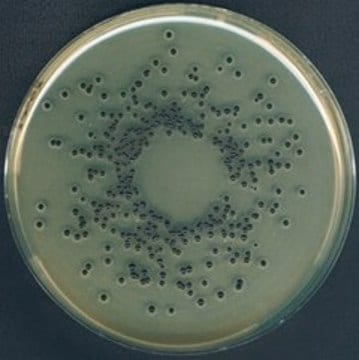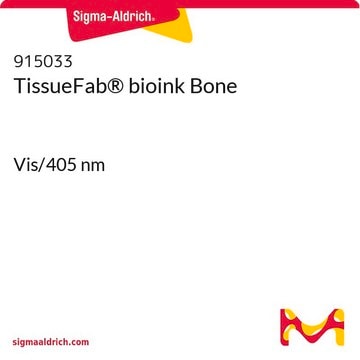927252
TissueFab® bioink
(GelAlgHA)MA Vis/405 nm, low endotoxin
Synonym(s):
AlgMA, GelMA, HAMA
Sign Into View Organizational & Contract Pricing
All Photos(1)
About This Item
UNSPSC Code:
12352201
NACRES:
NA.25
Recommended Products
description
HNMR in D2O at 40°C
Quality Level
form
(viscous liquid to gel)
impurities
<5 CFU/g Bioburden (Fungal)
<5 CFU/g Bioburden (Total Aerobic)
<50 EU/mL Endotoxin
color
pale yellow to colorless
pH
6.5-7.5
viscosity
10-30 cP(37 °C)
storage temp.
2-8°C
Looking for similar products? Visit Product Comparison Guide
General description
TissueFab® bioink -(GelAlgHA)MA Vis/405 nm, low endotoxin formulation is derived from natural polymers – hyaluronic acid, alginate, and gelatin. This ready to print bioink is optimized for 3D bioprinting of tissues and constructs using an extrusion-based 3D bioprinter. TissueFab® bioink -(GelAlgHA)MA Vis/405 nm, low endotoxin formulation can be used to bioprint cell-laden hydrogels in the desired shape without any supporting material and can be crosslinked in one step using exposure to UV light for further culture and maturation of cells for tissue engineering and regenerative medicine applications.
3D bioprinting is the printing of biocompatible materials, cells, growth factors, and the other supporting materials necessary to yield functional complex living tissues. Gelatin methacryloyl (GelMA) is a polymerizable hydrogel material derived from natural extracellular matrix (ECM) components. Due to its low cost, abundance, and retention of natural cell binding motifs, gelatin has become a highly sought material for tissue engineering applications. Hyaluronic acid (HA) is a linear polysaccharide of alternating D-glucuronic acid, and N-acetyl-D-glucosamine found in the extracellular matrix. HA is commonly chemically modified to form covalently crosslinked hydrogels. Alginate methacryloyl also known as AlgMA, is a polysaccharide widely used in tissue engineering obtained from brown algae.
3D bioprinting is the printing of biocompatible materials, cells, growth factors, and the other supporting materials necessary to yield functional complex living tissues. Gelatin methacryloyl (GelMA) is a polymerizable hydrogel material derived from natural extracellular matrix (ECM) components. Due to its low cost, abundance, and retention of natural cell binding motifs, gelatin has become a highly sought material for tissue engineering applications. Hyaluronic acid (HA) is a linear polysaccharide of alternating D-glucuronic acid, and N-acetyl-D-glucosamine found in the extracellular matrix. HA is commonly chemically modified to form covalently crosslinked hydrogels. Alginate methacryloyl also known as AlgMA, is a polysaccharide widely used in tissue engineering obtained from brown algae.
Application
3D bioprinting has been used to generate several different types of tissue such as skin, bone, vascular grafts, and cartilage structures. Based upon the desired properties, different materials and formulations can be used to generate both hard and soft tissues. While several 3D printing methods exist, due to the sensitivity of the materials used, extrusion-based methods with bioinks are most commonly employed.
Low Endotoxin, low bioburden: Endotoxins have been demonstrated negatively impact cellular growth, morphology, differentiation, inflammation and protein expression. Bioburden is defined as the number of contaminated organisms found in a given amount of material. We test each lot for endotoxins as well as total bioburden (aerobic and fungal) to minimize unwanted interactions. For more information: https://www.sigmaaldrich.com/US/en/technical-documents/technical-article/microbiological-testing/pyrogen-testing/what-is-endotoxin
Low Endotoxin, low bioburden: Endotoxins have been demonstrated negatively impact cellular growth, morphology, differentiation, inflammation and protein expression. Bioburden is defined as the number of contaminated organisms found in a given amount of material. We test each lot for endotoxins as well as total bioburden (aerobic and fungal) to minimize unwanted interactions. For more information: https://www.sigmaaldrich.com/US/en/technical-documents/technical-article/microbiological-testing/pyrogen-testing/what-is-endotoxin
Packaging
10 mL in HDPE bottle
Legal Information
TISSUEFAB is a registered trademark of Merck KGaA, Darmstadt, Germany
related product
Product No.
Description
Pricing
Storage Class Code
10 - Combustible liquids
WGK
WGK 3
Certificates of Analysis (COA)
Search for Certificates of Analysis (COA) by entering the products Lot/Batch Number. Lot and Batch Numbers can be found on a product’s label following the words ‘Lot’ or ‘Batch’.
Already Own This Product?
Find documentation for the products that you have recently purchased in the Document Library.
Emily Abelseth et al.
ACS biomaterials science & engineering, 5(1), 234-243 (2019-01-14)
3D bioprinting offers the opportunity to automate the process of tissue engineering, which combines biomaterial scaffolds and cells to generate substitutes for diseased or damaged tissues. These bioprinting methods construct tissue replacements by positioning cells encapsulated in bioinks into specific
Irene Chiesa et al.
Biofabrication, 12(2), 025013-025013 (2020-01-14)
Bone is a highly vascularized tissue, in which vascularization and mineralization are concurrent processes during skeletal development. Indeed, both components should be included in any reliable and adherent in vitro model platform for the study of bone physiology and pathogenesis
N Laurens et al.
Journal of thrombosis and haemostasis : JTH, 4(5), 932-939 (2006-05-13)
Fibrinogen and fibrin play an important role in blood clotting, fibrinolysis, cellular and matrix interactions, inflammation, wound healing, angiogenesis, and neoplasia. The contribution of fibrin(ogen) to these processes largely depends not only on the characteristics of the fibrin(ogen) itself, but
David B Kolesky et al.
Advanced materials (Deerfield Beach, Fla.), 26(19), 3124-3130 (2014-02-20)
A new bioprinting method is reported for fabricating 3D tissue constructs replete with vasculature, multiple types of cells, and extracellular matrix. These intricate, heterogeneous structures are created by precisely co-printing multiple materials, known as bioinks, in three dimensions. These 3D
Harold A Scheraga
Biophysical chemistry, 112(2-3), 117-130 (2004-12-02)
The thrombin-catalyzed conversion of fibrinogen (F) to fibrin consists of three reversible steps, with thrombin (T) being involved in only the first step which is a limited proteolysis to release fibrinopeptides (FpA and FpB) from fibrinogen to produce fibrin monomer.
Our team of scientists has experience in all areas of research including Life Science, Material Science, Chemical Synthesis, Chromatography, Analytical and many others.
Contact Technical Service








